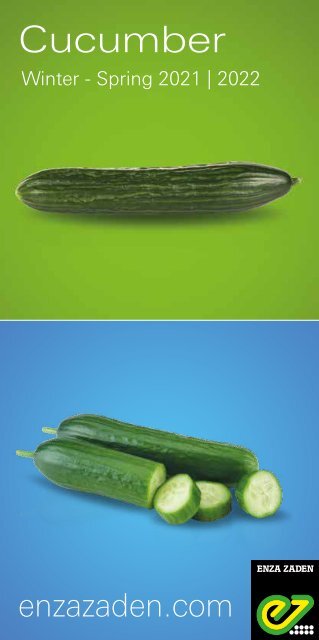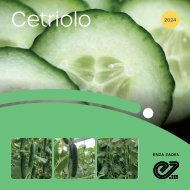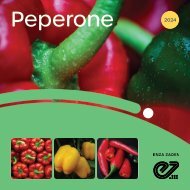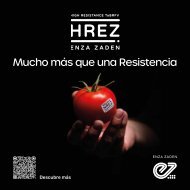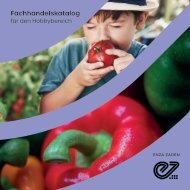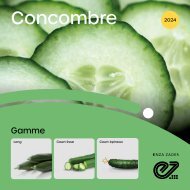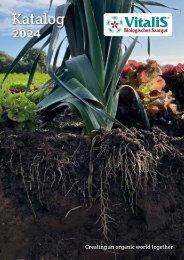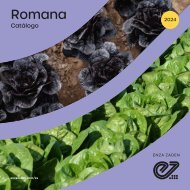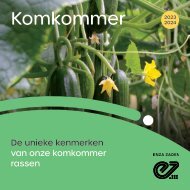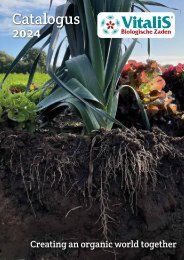Cucumber Scandinavia Winter Spring 2021-2022
You also want an ePaper? Increase the reach of your titles
YUMPU automatically turns print PDFs into web optimized ePapers that Google loves.
<strong>Cucumber</strong><br />
<strong>Winter</strong> - <strong>Spring</strong> <strong>2021</strong> | <strong>2022</strong><br />
enzazaden.com
Traditional crop<br />
Santiago<br />
Reliable, green and resistant<br />
• High production<br />
• Green and rapid growth<br />
• Strong regrowth through difficult periods<br />
• Intermediate resistance to powdery mildew<br />
Santiago is a new variety for traditional crops for planting in January.<br />
The variety has rapid growth and smooth green color throughout<br />
the entire season. It comes back sooner than other varieties<br />
which results in a solid balance between growth, fruit setting and<br />
production.<br />
The variety requires a generative cultivation regime to promote<br />
selectivity and openness of the crop. Even in longer cultivation<br />
periods this results in a high production level. Besides, Santiago<br />
provides an intermediate resistance to powdery mildew and also has<br />
a degree of CGMMV resistance.<br />
E23L.2391<br />
Production and fruit quality<br />
• High total production<br />
• Excellent fruit quality<br />
• Beautiful dark green fruit color<br />
• Open and labor friendly crop<br />
• Intermediate resistance to powdery mildew<br />
The new spring variety E23L.2391, with an intermediate resistance<br />
to powdery mildew, has been introduced at different growers last<br />
spring. It can be described best as an open and balanced crop,<br />
therefore it is a labor friendly variety. Due to this, this characteristic<br />
contributes to a very good fruit quality.<br />
Especially the dark green fruit color, the uniform fruit length and<br />
the fact that this variety performs well against Mycosphaerella will<br />
be traced back till the end of the crop. It is best to steer this variety<br />
towards growth to ensure a balanced crop. This will result in an open<br />
crop with small upstanding leaves.<br />
Because E23L.2391 is labor friendly, has a high total production and<br />
has an excellent fruit quality, the growers see this variety as a full<br />
alternative within the traditional segment.<br />
Enza Zaden | 3
Lighted winter crop<br />
E23L.2384<br />
Fruit quality and resistance<br />
• High resistance to powdery mildew and <strong>Cucumber</strong> green mottle<br />
mosaic virus (CGMMV)<br />
• Uniform production<br />
• High average fruit weight (400gr)<br />
• Compact and labor friendly crop<br />
E23L.2384 is a new variety in the lighted high wire segment. This<br />
variety scores very positive in a greenhouse with an intensive artificial<br />
light program, especially in combination with LED-lights.<br />
It distinguishes itself from other varieties by the high resistance<br />
to powdery mildew and to CGMMV. Moreover, the fruit quality<br />
in combination with the dark fruit color are also very positive<br />
characteristics.<br />
E23L.2384 is compact and has an average leaf size. The variety<br />
requires a more vegetative cultivation regime by planting it directly at<br />
full density and to avoid to pinched plants where possible. When the<br />
crop is in balance there will be a low fruit abortion, which results in<br />
an uniform production and an higher average fruit weight.<br />
Dee Rect<br />
Strong plant and resistant<br />
• High resistance to powdery mildew and <strong>Cucumber</strong> green mottle<br />
mosaic virus (CGMMV)<br />
• Strong green plant<br />
• Good fruit length<br />
Dee Rect is working well year-round for growers with a medium<br />
amount of artificial light. During the summer period it also can be<br />
grown without any extra lighting.<br />
It is an open and easy balanced plant type. Due to the fact that the<br />
leaves have an upright position, it allows direct light onto the fruits.<br />
At first the fruit length can be a bit short. However, very soon it will<br />
turn to a good fruit length of about 30 cm. Besides the fruits are of a<br />
very high quality.<br />
A big advantage is that Dee Rect has a high resistance to powdery<br />
mildew and CGMMV. This combination will give the variety a good<br />
protection to both pathogens.<br />
Enza Zaden | 5
Lighted winter crop<br />
Imea<br />
Highlight and high production<br />
• Powerful crop<br />
• Needs highlight intensity (>300 mmol) for a good balance<br />
• High production<br />
• Fruit weight between 330-380 gram<br />
• High resistance to powdery mildew<br />
For years now Imea has been the standard variety for highlighted<br />
crops in the <strong>Scandinavia</strong> market. It can be grown year-round. It is a<br />
vigorous crop that needs interlighting for generative growth. Imea is<br />
comfortable in high light conditions and can utilize the light for faster<br />
fruit setting and fruit filling.<br />
It has a very high production. In the first harvesting week the fruits<br />
can become a bit short (28 cm), but already in the second week this<br />
will change to fruits of about 32 cm in length. Also the fact that this<br />
variety has a high resistance to powdery mildew is a big plus in this<br />
highlighted segment.<br />
Kyra<br />
Powerhouse and consistent production<br />
• Easy to get in balance<br />
• High and stable production<br />
• Consistent fruit quality<br />
• High resistant to powdery mildew<br />
Kyra has a strong plant type with consistent growth. Recommended<br />
is to use this variety when growing towards the fall and winter<br />
season. This is because of the fact that the natural light from outside<br />
becomes less. For summer plantings this variety can become too<br />
strong. Kyra works very well under the highlighted conditions (>300<br />
micromole).<br />
The production starts early and is very consistent. The fruit quality<br />
is very high and stable throughout the full growing period. Almost<br />
no second class fruits are observed. Moreover, Kyra has a high<br />
resistance to powdery mildew.<br />
Enza Zaden | 7
Lighted winter crop<br />
Topvision<br />
Where strength and fruit weight predominate<br />
• Strong crop with coarse leaf<br />
• Longer fruit with good fruit weight<br />
• Steer towards generative growth<br />
• Stable production<br />
• Intermediate resistance to powdery mildew<br />
Topvision is a profit variety and works well at growers with a medium<br />
amount of light intensity. It is a balanced variety which delivers stable<br />
fruit length and – quality throughout the production period. Steering<br />
towards generative growth is preferred with this powerhouse.<br />
With its open and compact plant characteristic the plant type is<br />
very similar to Toplight. It has small to medium sized leaves and an<br />
intermediate resistance to powdery mildew. This variety is also fast to<br />
fill its fruits.<br />
Toplight<br />
Low light levels and lower average temperatures<br />
• Open and fast-growing crop<br />
• Can be cultivated at lower average temperatures<br />
• Fast fruit and good fruit weight<br />
• Intermediate resistance to powdery mildew<br />
Toplight is a variety that works well as a lighted crop in greenhouses<br />
with medium to lowlight intensity. Therefore it is very suitable in<br />
<strong>Scandinavia</strong> with the lower light levels of 90-250 micromole. It is a<br />
fast-growing crop including an early production.<br />
The open and generative plant type is easy to keep in balance.<br />
It is a compact plant with small to medium sized leaves. Besides, it is<br />
strong against fruit abortion. The fruit length is consistent (27-33 cm)<br />
and gives a nice even fill. Especially with night temperatures around<br />
17-17,5 Celsius.<br />
Enza Zaden | 9
Mini cucumbers<br />
Katrina<br />
A classic one with super taste<br />
• Most planted variety in its segment between 110 and 130 grams<br />
• Crispy and sweet<br />
• Open and steady growing crop<br />
• High resistance to powdery mildew<br />
• Strong against <strong>Cucumber</strong> green mottle mosaic virus (CGMMV)<br />
Katrina is a mini cucumber for traditional cultivation that can be used<br />
throughout the season. It can be planted from the end of January<br />
onto August. Its weights of 110-130 grams (length 16-18 cm) makes<br />
it a somewhat coarser mini variety.<br />
The quality and taste are the main features of this variety. The fruits<br />
are crispy and taste nice and sweet. The variety has a high resistance<br />
to powdery mildew. In practice it also shows to be strong against<br />
CGMMV too.<br />
The plant makes multiple fruits per node and grows very controlled<br />
on the laterals. Therefore it is advisable to twist the head over the<br />
wire.<br />
Analisa<br />
New for conventional and high wire cultivation<br />
• Open and generative crop<br />
• Suitable for conventional and high wire cultivation<br />
• High resistance to powdery mildew<br />
• Intermediate resistance to <strong>Cucumber</strong> green mottle mosaic virus<br />
(CGMMV)<br />
• Fruits between 90-110 gram<br />
Analisa has proven itself in either conventional as in high wire<br />
cultivations. It can be planted from the end of January onto August.<br />
It is an open an generative variety which produces an average of<br />
two fruits per node. It has an high production level and it is a labor<br />
friendly plant.<br />
Also the fruit quality is very consistent with a beautiful green color.<br />
It has weights of 90-110g (length 13-15 cm) makes it a bit smaller<br />
than the other mini cucumber variety Katrina. Those characteristics<br />
in combination with its high resistance to powdery mildew and the<br />
intermediate resistance to CGMMV makes it a very complete variety.<br />
Enza Zaden | 11
Planting schedule <strong>Cucumber</strong><br />
Variety Jan Feb Mar Apr May June<br />
Traditional crop<br />
Santiago<br />
E23L.2391<br />
Lighted winter crop<br />
E22L.2384<br />
Dee Rect<br />
Imea<br />
Kyra<br />
Toplight<br />
Topvision<br />
Mini <strong>Cucumber</strong>s<br />
Katrina<br />
Analisa<br />
Variety July Aug Sept Oct Nov Dec<br />
Traditional crop<br />
Santiago<br />
E23L.2391<br />
Lighted winter crop<br />
E22L.2384<br />
Dee Rect<br />
Imea<br />
Kyra<br />
Toplight<br />
Topvision<br />
Mini <strong>Cucumber</strong>s<br />
Katrina<br />
Analisa<br />
Enza Zaden | 13
Resistances<br />
Explanation of used abbreviations<br />
Resistances in varieties of our crops will be coded (please, see our<br />
coding list on www.enzazaden.com for explanation), unless indicated<br />
otherwise.<br />
Code Engish name Scientific name pathogen ISF<br />
Level of<br />
resistance<br />
Varieties claiming the same level of resistance against a specific<br />
pest or pathogen may exhibit a different resistance response due<br />
to a different genetic makeup of a variety. It is to be noted that if a<br />
resistance is claimed in a plant variety it is limited to the specified<br />
biotypes, pathotypes, races or strains of the pest or pathogen.<br />
Fungus<br />
Cca Target leaf spot Corynespora cassiicola HR<br />
Ccu Scab Cladosporium cucumerinum HR<br />
If no biotypes, pathotypes, races or strains are specified in the<br />
resistance claim for the variety, it is because no generally accepted<br />
classification of the cited pest by biotype, pathotype, race or strain<br />
exists. In this case resistance is only claimed against certain not<br />
further specified isolates of that pathogen. New biotypes, pathotypes,<br />
races or strains that may emerge are not covered by the original<br />
resistance claim.<br />
Virus<br />
Px Powdery mildew Podosphaera xanthii IR, HR<br />
CMV<br />
<strong>Cucumber</strong><br />
mosaic<br />
<strong>Cucumber</strong> mosaic virus IR<br />
CVYV<br />
<strong>Cucumber</strong><br />
vein yellowing<br />
<strong>Cucumber</strong> vein yellowing virus IR<br />
Immunity: not subject to attack or infection by a specified pest or<br />
pathogen.<br />
Resistance: the ability of a plant variety to restrict the growth and<br />
development of a specified pest or pathogen and/or the damage they<br />
cause when compared to susceptible plant varieties under similar<br />
environmental conditions and pest or pathogen pressure. Resistant<br />
varieties may exhibit some disease symptoms or damage under<br />
heavy pest or pathogen pressure.<br />
CGMMV<br />
<strong>Cucumber</strong> green<br />
mottle<br />
<strong>Cucumber</strong> green mottle mosaic<br />
virus<br />
IR, HR<br />
Two levels of resistance are defined:<br />
• High resistance (HR): plant varieties that highly restrict the<br />
growth and development of the specified pest or pathogen<br />
under normal pest or pathogen pressure when compared<br />
to susceptible varieties. These plant varieties may, however,<br />
exhibit some symptoms or damage under heavy pest or<br />
pathogen pressure.<br />
• Intermediate resistance (IR): plant varieties that restrict the<br />
growth and development of the specified pest or pathogen,<br />
but may exhibit a greater range of symptoms or damage<br />
compared to highly resistant varieties. Intermediate resistant<br />
plant varieties will still show less severe symptoms or damage<br />
than susceptible plant varieties when grown under similar<br />
environmental conditions and/or pest or pathogen pressure.<br />
Susceptibility: the inability of a plant variety to restrict the growth<br />
and development of a specified pest or pathogen.<br />
Tolerance: the ability of a plant variety to endure abiotic stress<br />
without serious consequences for growth, appearance and yield.<br />
Vegetable companies will continue to use tolerance for abiotic stress.<br />
Full explanation available on www.enzazaden.com<br />
Disclaimer<br />
Descriptions, recommendations and illustrations in brochures and<br />
leaflets shall correspond as closely as possible to tests and practical<br />
experience and are subject to typographical and/or printing errors.<br />
This information shall be provided to assist professional growers and<br />
users, whereby variable local conditions must be taken into account.<br />
Under no circumstances shall Enza Zaden accept liability based<br />
on such information for deviating results in the cultivated product.<br />
Current information concerning the resistances is available on www.<br />
enzazaden.com<br />
© Enza Zaden | Enkhuizen | The Netherlands | October <strong>2021</strong><br />
14 | Enza Zaden<br />
Enza Zaden | 15
enzazaden.com<br />
Your contact person:<br />
Malene Antonsen | Product Specialist<br />
Enza Zaden <strong>Scandinavia</strong><br />
m.antonsen@enzazaden.dk<br />
tel +45 22 16 40 80


